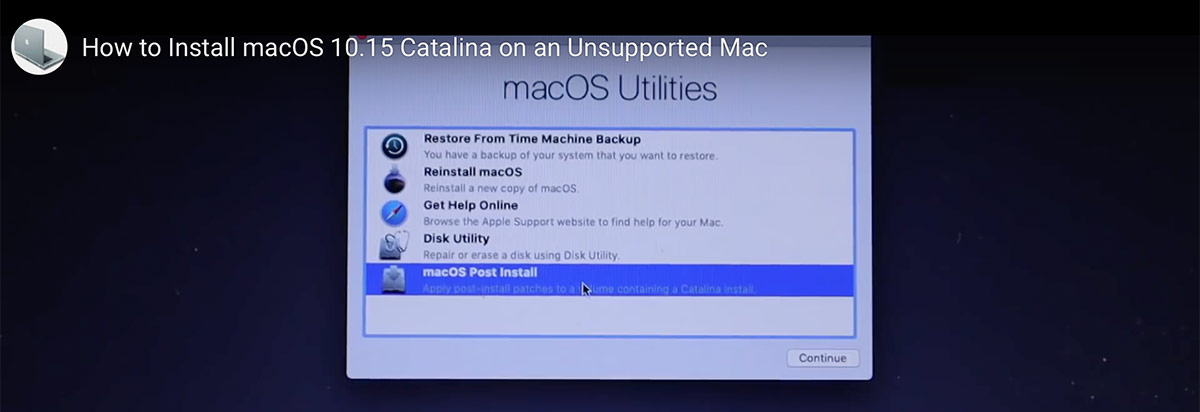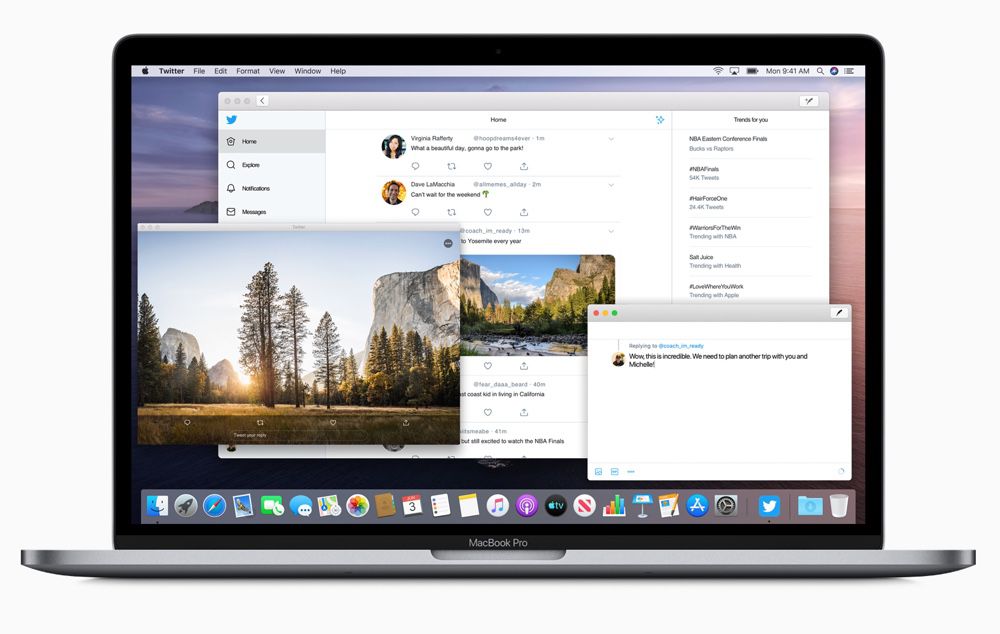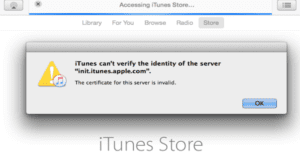DeMux
MacOS Catalina Patcher lets you install macOS Catalina on Mac computers that are no longer officially supported. It can help you create a bootable USB drive that can be used to install macOS Catalina on Mac computers older than mid 2012. MacOS Catalina Patcher The easy way to run macOS Catalina on your Unsupported Mac APFS BootROM Support: Early-2008 or newer Mac Pro, iMac, or MacBook Pro: Late-2008 or newer MacBook Air or Aluminum Unibody MacBook: Early-2009 or newer Mac Mini or white MacBook: Early-2008 or newer Xserve: Machines that ARE NOT supported: 2006-2007 Mac Pros, iMacs, MacBook Pros, and Mac Minis: The 2007 iMac 7,1. MacOS Catalina won't work on older Macs, but thanks to dosdude1's patcher, it can! Dosdude1 himself makes a cameo in this episode. I used dosdude’s method to update an old 2009 MBP to Catalina, and it went fine. Watch his youtube video, there’s some steps to follow. But now I have a machine that wasn’t much use to me that I can test Catalina on without affecting my main machine (which is still on Mojave for the time being). Background: I installed successfully Catalina 10.15 on a clean 512Gb EVO Samsung PCIe SSD drive a few weeks back with the DOSdude1 method on my Mac Pro 5,1 from 2009 (upgraded in steps throughout the years to 2x 6-core Xeon 3,46 GHz NVIDIA GeForce GTX 780 (Metal support), BootROM 141.0.0.0.0 (upgraded in steps too through the great help from.

Firmware to disable the defective dedicated AMD GPU on 2011 MacBook Pro models. A permanent solution for radeongate.
NOW WITH NATIVE BACKLIGHT CONTROL! (See details)

Please read this page in its entirety before purchasing to understand what is required.
We are accepting mail-ins! The base rate is $60+SH for a flash. Only $40+SH if you already bought a key. Please contact us if you would like to do a mail-in.
If you have already got everything set up, you canPurchase A License Key (If you would like to do a bulk order please contact us before purchasing, we may be able to give you a discount.)
Important Notes
(Seriously, these are important.)

- For those with repeated failed flashes, please complete the following steps while flashing:
- Short PLT_RESET_L from Pin 1 of R2881 to any GROUND using a jumper wire (a reference grounding point is shown in the below images).
- Power on the machine. (While still shorting PLT_RESET_L)
- Proceed to flash normally. (While still shorting PLT_RESET_L)
- Remove jumper wire.
- Hard reboot machine.
15' PLT_RESET_L Diagram
17' PLT_RESET_L Diagram - If you are getting errors saying a DLL is missing please install the following Microsoft Redistributable (it is also packaged with the DeMux download as 'vcredist_x64.exe'):
Microsoft Visual C++ 2012 Rev4
Please make sure you are installing the 64-bit version by selecting it in the menu that comes up when you click 'Download'. - DisplayPort is a functionality of the dedicated GPU only, disabling the dedicated GPU will also disable the DisplayPort.
Table of Contents
- A Lattice HW-USBN-2A ICSP FPGA Programmer (you can get one cheaply here)
- Wires and connector to connect from the Lattice programmer to the MacBook logic board.
- A copy of the DeMux flashing software

Installing the software
Installing the software comes in three steps. First, download the package, and extract it. You should then connect your programmer and install the programmer drivers. After this is done, you can purchase a flash license from us and use it with the DeMux utility to flash your gMux IC. These steps are covered in further detail below.
Downloads
A 64 Bit Windows system is required to use DeMux.

Download one of the following packages:
Download PGP Signed VersionMirrorOnce the package is downloaded, go ahead an extract it somewhere safe. You are now ready for the next step.
Drivers
Once the package has been extracted, plug your Lattice HW-USBN-2A ICSP programmer into a USB port on your computer. Then, open the driver installer executable, and use it to install the USB driver. The program will tell you if it was successful.
License keys
If you don't yet have a license key, you'll need to purchase one. Keys cost $20 each, and are good for one gMux IC flash. Once purchased, save the key in a safe place, as it will be needed later. (If you would like to do a bulk order please contact us before purchasing, we may be able to give you a discount. A discount table is available on the purchasing page.)
DeMux client
Next, open up the DeMux flashing application. Here, you will need to enter the license key you purchased. If it's a valid key, the program will indicate so. Once the license has been verified as valid, you can proceed to the next steps.
- Please note that once a license key is verified as valid on one machine, it CANNOT be used on another.
Preparing your programmer
In order to prepare the hardware for gMux flashing, you will need to correctly connect your Lattice programmer to the gMux IC JTAG header of your MacBook logic board. This will require either soldering wires to each pad of the header, or using our custom pogo-pin solderless connector (coming soon).
When soldering the wires on a 15' board, please be sure to route them away from or around the large black inductor, located just to the right of the JTAG header. This inductor will interfere with the data lines if they are routed overtop of it. This leads to a failed flash.
Soldering
Important note: Only use a temperature controlled soldering iron or you WILL remove pads which are required for the flash to work. Most of the pads are ONLY available in this ONE place. The loss of a pad will PERMANENTLY ruin your ability repair the board.
To solder the JTAG wires to the logic board, start by tinning each of the 6 header pads with fresh solder. Then, strip and tin 6 wires that you can connect to your Lattice programmer. Solder each wire to the respective pin, as shown in the diagrams below (click image for higher definition):
There is now a video detailing these steps available:
No soldering
Dosdude Catalina Patch
We are selling the adapter in limited quantities as a pre-release to high volume customers only. You must meet the following requirements to be able to purchase:
- Flash a minimum of 25 machines a month.
- Are a repair shop of some kind.
- Will continue to have a use for the adapter after its initial use.
Dosdude1 Catalina Patch
No other customers will be considered at this time.
Flashing
Lastly, once your Lattice programmer is properly connected to the logic board, and you have a valid license entered in the DeMux flashing utility, you are ready to proceed with flashing. To flash, perform the following steps:
- Apply power to the logic board. To do so, simply connect the machine to power, and turn it on. It is recommended that you disconnect all hard disks during this process, to prevent the machine from booting into an OS. When the machine is powered on, the status LED on your Lattice programmer will turn from amber to green.
- Once the LED is stable solid green, you are ready to press the 'FLASH GMUX' button in the DeMux flashing utility. This process will take a bit to complete, so be patient.
- Do NOT disconnect the Lattice programmer, close the DeMux flashing utility, or power off the machine during this process.
- If the process fails, check your JTAG connections and try again. If successful, turn the machine off and back on, and you should now be running only off Intel HD Graphics, indicating that the DeMux firmware was flashed successfully. You can verify this in System Report by selecting 'Graphics/Displays' and checking that 'gMux Version' is:
d0.51.ab
Backlight Control
DeMux now supports native backlight control. How this is done depends on the version of macOS you plan to run on your system.
- For macOS < 10.13 High Sierra - Out of the box support, simply flash and use.
- For macOS 10.13 High Sierra - Follow these steps:
- Reboot the machine while holding CMD+R.
- Once recovery mode is booted open the terminal and enter the following:
csrutil disable - Reboot the machine.
- Install this package (mirror).
- For macOS > 10.13 High Sierra - utilize a dosdude1 Patcher to install the 'Backlight Control Patch' via Patch Updater.
- For Linux - Natively supported.